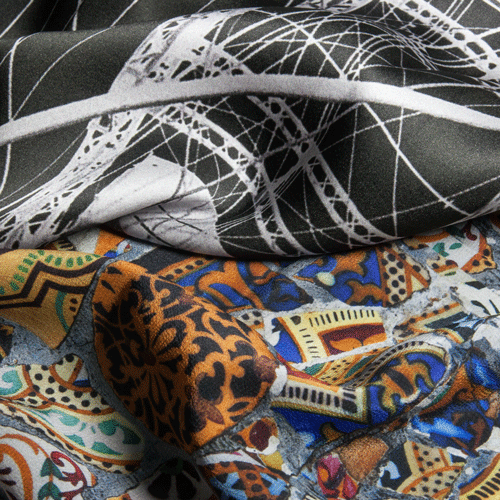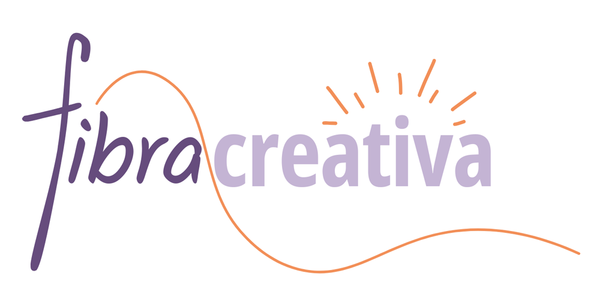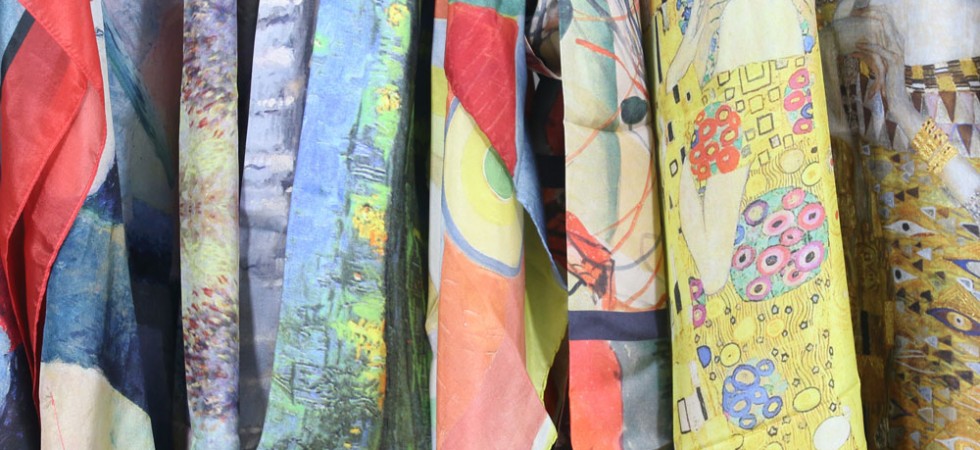
Silk printing: all about about fabrics, inks, results
Share
Traditional silk printing, usually done by screen printing, is increasingly being done by digital textile printing, which offers many advantages. However, not all digital printing techniques are equal, and it is important to choose well to get the best result.
Fashion professionals, artists, designers, this article explains how to print your designs on natural silk, this magnificent and noble material, to achieve the best quality.
Direct high-definition inkjet printing on silk
All our textile prints are made by full-color digital printing.
- Textile digital printing direct on the fabric (no sublimation) in high definition.
- Acid inks specific to the fiber type for an optimal result on silk. Reactive or pigment inks sometimes used by some suppliers do not give as beautiful results on silk.
- Bright and saturated colors
- Soft touch of the fabric, with a very beautiful drape, as acid inks penetrate the silk fabric.
- Excellent rendering of fine details.
- Washable printed fabric (delicate mode in cold water, as it is natural silk).
- Possibility to distribute multiple designs over a length of fabric.
- 100% European printing, locally done in Catalonia (Spain).
Which natural silk fabrics can be digitally printed?
Textiles suitable for digital printing generally need to have specific characteristics:
- a rather smooth surface, although a slight texture, like that of silk twill, a diagonal weave, does not interfere at all.
- a white background
- a specific pre-treatment of the fabric to ensure print quality
Types of natural silk fabrics for digital printing
In general, among natural silk fabrics suitable for digital printing, you will find these, in various weights, expressed in momme (an old Japanese unit of measurement) or in grams per square meter.
- Silk muslin
- Silk pongee
- Silk twill
- Silk satin
- Silk crepe
Pre-treatment of silk fabrics
Silk fabrics printed with acid or reactive inks must be prepared with a specific treatment before printing. For this reason, it is much simpler to choose from the range offered by the printer than to bring your own fabric.
Fibra Creativa offers a selection of silk fabrics from Italy and does not work with fabrics brought by clients.
Background color of silk fabrics
Textile digital printing is done on rolls of white silk fabric (the exact shade of white may vary). It is not possible to print on dark-colored silk fabrics (for example, printing a white pattern on a dyed black silk fabric).
However, it is perfectly possible to print a background color if desired.
Which inks for digital printing on silk?
In digital printing, there are various types of inks, which are suitable or not for each material. To achieve the best result, it is important to use the inks that best suit the type of fiber.
Among natural fibers, silk and wool have the particularity of being protein fibers of animal origin. Silk is secreted by the silkworm, wool grows on the backs of sheep, while natural fibers of plant origin come from plants like cotton, flax, or hemp.
The acid dyes are particularly suitable for digital printing on protein fibers as they create a strong chemical bond with the protein fibers of these textiles. This allows for the following:
- very bright and vivid colors,
- an excellent wash fastness,
- a good lightfastness,
- and a soft touch, without altering the fabric's suppleness.
Why are these inks so effective?
Natural fibers like silk and wool are made of proteins (sericin, keratin), which react very well with acid dyes. After printing, the ink is fixed by steam, allowing the dyes to penetrate deeply into the fiber, ensuring a rich and durable finish.
Can other types of inks be used to print on silk?
Yes, but with compromises:
- Reactive inks: Usable on silk, they also offer good fastness but are more designed for cellulosic fibers (like cotton). The finish is often less vibrant than that obtained with acid dyes.
- Pigment inks: They can be applied to almost all fabrics, including silk, without chemical reaction with the fiber. The ink remains on the surface, resulting in a less intense finish, lower wash durability, and a drier feel. Fluid silks like satin lose their beautiful "hand".
- Sublimation inks: Incompatible with silk and wool, as they require synthetic fibers like polyester to fix properly.
In summary, for silk (and wool), acid dyes remain the reference choice if you are looking for a professional, vibrant, and durable finish. Other inks can be useful or suitable for certain uses, but they do not match the finesse and depth of colors obtained with acid dyes.
Printing colors and patterns on silk
High definition inkjet printing allows printing a wide range of colors and patterns, with some limitations.
Colors
Inkjet printing consists of depositing a multitude of tiny drops of colored inks onto the fabric. It is therefore possible to print a very wide variety of colors. Of course, it is also possible to print a black and white or monochrome design.
The number of colors included in a pattern normally does not affect the printing price, unlike screen printing, where the price varies depending on the number of colors in the pattern.
However, there are currently no metallic inks (gold, silver...) for textile digital printing. A metallic effect can be reproduced by working on color gradients in the design.
There is no white ink for printing on silk. When the digital file contains pure white (#ffffff), it is the color of the base fabric that will be visible.
Note that the exact tone of a color on screen may vary in printing, depending on the calibration of the screen and the printer.
Visibility of colors and patterns on the back of the silk fabric
For certain uses, particularly silk scarves, it is important that patterns and colors are clearly visible on the back.
Contrary to a common misconception, printing is not done on "both sides of the fabric." However, inks printed on the front penetrate the fiber and are visible on the back, more or less depending on the thickness of the silk fabric and the type and amount of ink used.
Ink penetration is better with acid inks, which penetrate the fiber, and on thin fabrics like silk muslin, and less good on thicker fabrics, from 14 momme. However, today some printers specialized in silk printing can apply specific products that improve ink penetration to the point that front and back are indistinguishable, even on thicker fabrics.
Pattern rendering
Color and texture gradients look very good, as do multicolored patterns. It is possible to print solid color patterns, but large solid color areas are not the strong point of digital printing.
Photographs, reproductions of paintings, drawings, textures, look particularly good.
Continuous printing of matching patterns or printing of placed patterns
Depending on your needs, it is possible to print on silk:
- du continuous yardage from a matching pattern.
- des panels (printing with placed patterns). This printing method opens many possibilities. Be careful, in manufacturing it also requires many calculations to optimize the use of the fabric width and the placement of pattern pieces and cutting.
File preparation for digital printing on silk
Digital printing is done from digital files (obviously) in JPF, PNG, TIF, or PDF format, at 150, 200, or 300 dpi resolution depending on the printers, generally in RGB mode.
If you create your own files, Fibra Creativa precisely indicates the required characteristics according to the project. We can also adapt your images (paintings, photos, drawings...) from the files you send us.

